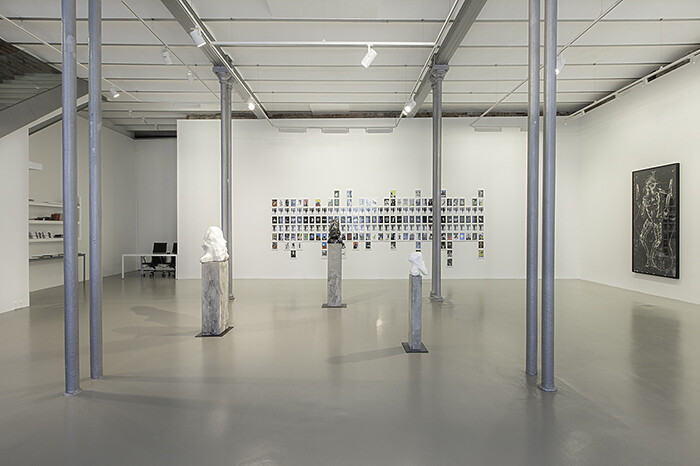“Who Shall Deliver Us From the Greeks and Romans?”—an exhibition curated by Cristiana Perrella for Galeri Manâ—directly addresses a recent trend in contemporary art of looking back towards classical Greek and Roman visual culture for sources and inspiration. The presentation includes works from a range of artists from different backgrounds—such as Lisa Anne Auerbach and Aleksandra Mir; Steven Claydon; Özlem Günyol and Mustafa Kunt; Matthew Monahan; Jonathan Monk; and Liam Gillick—which oscillate between mimetic homages of the classical ideal and a more self-reflexive critique of Antiquity’s influence throughout the history of art. Each of the artists’ visual subversions of common classical objects are subtle, demonstrating the exhibition’s success in creating a critical distance to the Greek and Roman artistic legacy.
Upon entering Galeri Manâ’s lofty space—a converted wheat mill—one encounters Daniel Silver’s new series of untitled busts on pedestals. These works, which closely resemble their antique counterparts, affirming the exhibition’s point of departure, set the stage for a range of practices that stand in differing relation to the classical past. Hanging beside Silver’s sculptures are Francesco Vezzoli’s laser prints of “crying” busts on canvas, with titles like EMPEROR CALIGULA CRYING FRANCIS BACON’ FIGURES AT THE BASE OF A CRUXIFICATION (2014), which literally have tears of Botticelli’s flowers or Bacon’s figures painted, drawn, and embroidered onto them. This juxtaposition produces a dialogue between two methods of appropriation: one that results in work that looks and feels very much like the original, but is a twisted version of it, like Silver’s Untitled (mask beard) (2014), and another that ends up with an exact replica of a pre-existing object, making the act of appropriation even more overt, as seen in Aslı Çavuşoğlu’s Sitting on a Tell (2014). However, Vezzoli’s hybridization spans such a broad historical period and range of content that its beautifully crafted stitching becomes a central theme for the entire exhibition—crossing, hybridizing, and relating both historical and visual tropes.
Pedro Reyes’s Los Mutantes (2012)—a wall of images, many repeated, some unique—is the first work in the exhibition to play directly with temporality and narrative. Reyes’s source materials range from comics to photographs of people on the street, hinting at a relationship between people’s postures and idealized sculptures. The artist’s visual repetition of the same woman seen from behind, feet slightly apart, is both romantic and playful. Upstairs, Gregory Crewdson picks up the theme of temporality again in a 2009 series of untitled photographs of “classical” objects—fragments of Greek or Roman statues—as a testament to both their beauty and the passage of time. Overgrown leaves poke through the remnants of what seems to have been a human figure; the hint of flowing robes, too, is a subtle reminder of mortality, as well as the object’s own strange afterlife. Crewdson’s decision to shoot the images in black-and-white alleviates them of the weight of full color; instead of being overburdened by color’s specificity, the photographs can engage more deeply with the medium’s flattening of time.
A meticulously crafted video of almost twenty-six minutes, Adrian Paci’s The Column (2012) is a tour de force in every sense, and exemplifies the curator’s ambitions for the exhibition. Paci’s documentation of the movement of a marble slab from a quarry onto a ship, where contracted Chinese workers craft it in the open air into an ancient Greek-style column, is absolutely hypnotic. The artist builds up such a rhythm in the piece that each mark, each gesture towards—or in relation to—the marble becomes monumental. Caught in suspense, the viewer yearns for the final form to emerge.
While the scope of the exhibition’s practices and positions produces a dynamic movement, it is impossible not to wonder whether it is desirable for Paci’s work to shift one’s experience of the entire exhibition towards a conclusion that differs from the show’s stated interests. Encompassing two floors, the architecture of the gallery space—with Paci’s enclosed projection located at the far corner of the second floor—dictates that after having watched the piece, one must then walk past the works on the second floor and take the stairs overlooking the first floor’s display on the way down to the exit. Thus, The Column’s subtext of materialized global labor governs this second viewing, making it impossible not to wonder whether the “intimate” relationship shared amongst the other works on view is actually not reductive.
Reyes, Crewdson, and Paci all deal with temporality, loosely extrapolating from the legacy of Antiquity, while most of the other artists literalize this reference—at least visually—by creating a dichotomous experience that oscillates between specific parody and internalized criticality. Perhaps the intractability of this legacy is best grasped through such variation, but as a viewer, it is impossible not to be seduced by the presentation’s more generalized statements, which fluctuate between humorous, anachronistic juxtapositions of the old and new, and reflections on how artistic research relates to archeological excavation.










